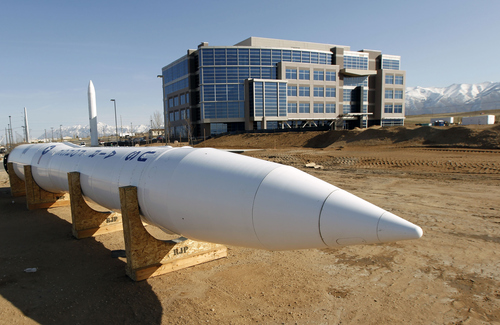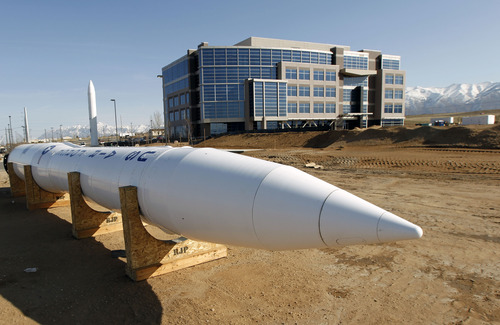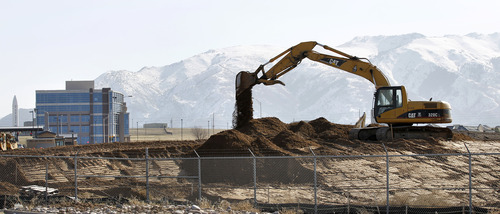This is an archived article that was published on sltrib.com in 2012, and information in the article may be outdated. It is provided only for personal research purposes and may not be reprinted.
Falcon Hill research park, slowly taking shape on the west side of Hill Air Force Base, may one day be a huge economic engine for northern Utah.
In the meantime, though, the park and its promise is something else: a piece of armor against the coming storm of military budget cuts.
That's because the novel way the park is organized gives HAFB new buildings and roads without asking a strapped Uncle Sam to chip in.
The new infrastructure is essentially the base's profit for letting a private developer — a joint venture of Woodbury Corp. of Salt Lake City and Hunt Companies of El Paso, Texas — build on 500 acres along a 3.5-mile stretch of Interstate 15 as well as on an additional 50-acre parcel near the base's flight line.
"We at Hill could be in a position to support the Air Force needs without having to go back to Congress," says Dave Williamsen, chief of the Enhanced Use Lease (EUL) office at Hill.
That's a point Utah's congressional delegation makes as it urges the Air Force to keep, expand or bring new missions to Hill.
The Falcon Hill National Aerospace Park is the largest enhanced-use lease office project in Department of Defense history. This fall, it won an innovation award from The National Council for Public-Private Partnerships. In 2009, the Air Force's chief of staff honored Hill's EUL office as one of five groups in the Air Force that will save the military billions of dollars over time.
As part of its contract with the Woodbury-Hunt partnership, Sunset Ridge Development, Hill is to get 1.5 million square feet in new office space as the park is developed over 20 to 25 years.
Some of the new buildings will replace the 140 small World War II-vintage warehouses the base has been using for offices. The first of those is to be demolished next year, Williamsen says.
But uncertainty about the depth of military cuts has made defense contractors skittish, so leases are not yet in place to begin work on the park's second office building, Williamsen said.
"Once that's settled, the second building will probably start [construction] this spring," he said. It will go in the cluster of buildings where Northrop Grumman's five-story office building opened last spring.
The developer is also seeing some interest in retail and restaurant buildings in the part of the park that will be outside the West Gate, Williamsen said.
While the market will dictate the development pace, Hill already has received $20 million worth of new construction, which is far higher than the $13 million market value initially put on Hill's property, said Erik Castle, Hill's project manager for Falcon Hill.
That $20 million includes the new West Gate, which was pushed farther east to minimize traffic backup on Interstate 15 through Clearfield, and a new Security Forces building, finished earlier this year.
One key aspect of Falcon Hill, Williamsen and other say, is the role played by state and local governments.
By January this year, the state had contributed $19 million, according to an Air Force white paper, and the Utah Department of Transportation provided $10 million for reworking the West Gate and road.
The Military Installations Development Authority (MIDA) — an economic development authority created by the Legislature in 2007 — had issued $2.5 million in tax increment bonds and expected to provide an additional $30 million in grants and bonds to improve base infrastructure and support the aerospace industry, the white paper said.
MIDA takes the place of the four cities and two counties that otherwise would need to be involved in approving Falcon Hill's development. It's run by Rick Mayfield, the former Utah economic development director.
Tage Flint, president of the Utah Defense Alliance, says the local investment should send a message to the Pentagon as it contemplates cuts.
"It's an indication to the Air Force at large that Utah is committed to having them here," says Flint. "We welcome them here."
Related story: The fight for Hill Air Force Base







